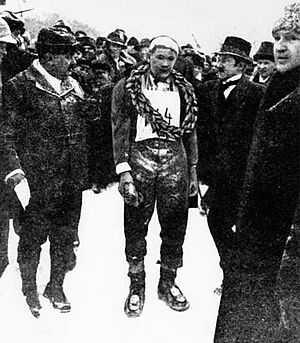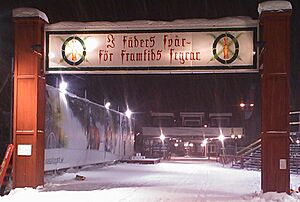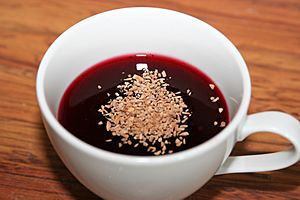Vasaloppet facts for kids
Quick facts for kids Vasaloppet |
|
|---|---|
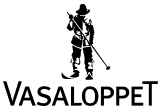 |
|
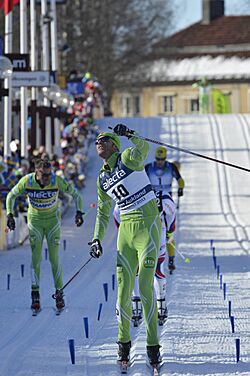
Jørgen Aukland, Norway, winning the 2013 men's event
|
|
| Status | Active |
| Genre | Sports event |
| Date(s) | First Sunday in March |
| Frequency | Annually |
| Location(s) | Sälen–Mora |
| Country | Sweden |
| Years active | 103 |
| Inaugurated | 1922 |
| Founder | Anders Pers |
| Participants | 15,800 |
| Attendance | 70,200 (2015) |
| Budget | SEK 120 million (2012) |
| Activity | Cross-country skiing |
| Organised by |
|
| Sponsor | |
Vasaloppet (which means 'the Vasa race' in Swedish) is a very famous long-distance cross-country ski race. It happens every year on the first Sunday of March in Sweden. The race is about 90 km (56 mi) long. It starts in a village called Berga, near Sälen, and finishes in the town of Mora.
Vasaloppet is the oldest cross-country ski race in the world. It also has the most people taking part! The race was inspired by a famous journey made by King Gustav Vasa way back in 1520. He was trying to escape from soldiers and, according to stories, he fled on skis. The modern race started in 1922. Since 1979, it has been part of the Worldloppet Ski Federation events.
Contents
The Story Behind the Race
In 1520, a young nobleman named Gustav Ericsson Vasa was running away. He was fleeing from the soldiers of King Christian II, who ruled Denmark, Sweden, and Norway. Many Swedish nobles did not like King Christian and called him Christian the Tyrant.
King Christian had invited many Swedish nobles to a party in Stockholm. But it was a trick, and he had them all killed. This terrible event was called the Stockholm Bloodbath. Gustav's parents were among those who died.
Gustav escaped and fled through a region called Dalarna. He was very afraid of being found by the king's troops. He tried to convince the men of Mora to start a rebellion against King Christian. But they refused to help him. So, Gustav started skiing west, hoping to find safety in Norway.
However, the men in Mora soon changed their minds. They heard that the Danish rulers were going to raise taxes, and they became angry. They decided they wanted to join the rebellion with Gustav as their leader. They sent their two best skiers, Lars and Engelbrekt, to find him. They caught up with Gustav in Sälen.
On June 6, 1523, Gustav Vasa became the King of Sweden. He had defeated the Danish king and made Sweden an independent country. The modern Vasaloppet race runs the opposite way of Gustav's famous journey, ending in Mora.
How the Race Started
The idea for the Vasaloppet race was first shared in a newspaper on February 10, 1922. Anders Pers from Mora wrote about it. A month later, on March 5, 1922, the IFK Mora sports club decided to hold a trial race.
A newspaper called Dagens Nyheter helped by giving money for the race. With the money secured, the very first Vasaloppet was held on March 19, 1922. There were 136 people who signed up, and 119 actually started the race. The first winner was 22-year-old Ernst Alm. He finished in 7 hours, 32 minutes, and 49 seconds. He was the youngest winner for a very long time, until Alvar Myhlback won in 2025 at age 18.
In 2004, about 15,500 skiers took part in the main race. More than 40,000 people participated in all the different races held during the "Vasaloppet week." Vasaloppet is also part of the Ski Classics long-distance race series.
In 1986, the Swedish Prime Minister Olof Palme was killed just two days before the race. People thought about canceling the race that year. But it went ahead as planned. The 10,000 participants had a moment of silence before the start.
Women in Vasaloppet
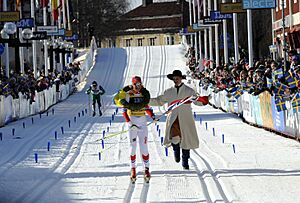
Women have been officially recognized as winners in Vasaloppet since 1997. Before that, from 1922-23 and 1981-96, women could race but did not get awards. The first woman to ever participate was Margit Nordin in 1923. She finished in 10 hours, 9 minutes, and 42 seconds. A newspaper wrote that she received "an incredible ovation" and was "lifted high on strong arms."
For many years after the first race, there were big discussions about women racing. Most officials, mainly men, thought it was bad for women's health to compete in such a tough race. So, women were banned from 1924 until 1980. This ban was criticized, especially after 1960. Some people who supported the ban said that allowing women would make the race seem less challenging.
However, some women still raced during the ban by dressing up as men! In 1978, two women, Birgitta Westhed and Britt Dohsé, even got help from a professional make-up artist. They used wigs, moustaches, and full beards to change their appearance. Westhed was even interviewed on TV during the race. This helped bring more attention to women wanting to participate.
The Vasaloppet Motto
The motto of Vasaloppet is I fäders spår för framtids segrar. This means 'In [our] fathers' tracks for future victories'. These words are written on a special archway at the finish line in Mora.
At the very first race, the finish line was just a white board between two flag poles. It simply said Mål ('Finish'). For the second race, a grander arch with the motto was built. In 1986, this archway became a permanent structure. It is now a very important landmark in Mora.
Kranskulla and Kransmas
A special tradition at Vasaloppet is choosing a kranskulla. This is a woman who has the honor of placing a laurel wreath around the neck of the race winner. She wears a traditional folk costume from Dalarna.
When a women's race, Tjejvasan, was added in 1988, a male kransmas was also chosen. Both the kranskulla and kransmas act as special representatives for the race throughout the year.
How the Race Works
Race Organization
The Vasaloppet race is run by a non-profit group called Vasaloppsföreningen Sälen-Mora. This group was officially registered in 1992. It is owned by two local sports clubs: IFK Mora and Sälens IF. About 35 people work full-time all year to plan and prepare for the events.
Food and Drink Stations
Since 1958, a special drink called blåbärssoppa ('bilberry-soup') has been served at stations along the course. This soup is made by Ekströms food company. About 50,000 liters of it are served during the Vasaloppet week! Skiers also get sports drinks and special "Vasaloppet buns." Coffee is served at the Eldris station.
For many years, the word blåbär was printed in big letters on the number tags worn by skiers. This word means 'bilberry' but it also means 'rookie' or beginner. So, participants were sometimes called blåbär, which was a funny play on words!
Vasaloppet Stations
- Berga by, 0 km (0 mi) (Start)
- Smågan, 11 km (6.8 mi)
- Mångsbodarna, 24 km (15 mi)
- Risberg, 35 km (22 mi)
- Evertsberg, 47 km (29 mi)
- Oxberg, 62 km (39 mi)
- Hökberg, 71 km (44 mi)
- Eldris, 81 km (50 mi)
- Mora, 90 km (56 mi) (Finish)
The Rope
"The Rope," also known as "The Dreaded Rope," is a series of ropes placed across the track at certain times. These ropes stop skiers who are too far behind to finish the race before the course closes. The ropes are at seven stations: Smågan, Mångsbodarna, Risberg, Evertsberg, Oxberg, Hökberg, and Eldris. The race starts at 8:00 a.m., and the finish area closes at 8:15 p.m.
Vasaloppet Week
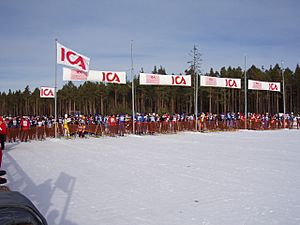
The week before the main Vasaloppet race is called Vasaloppet week. During this week, several other races are held:
- Kortvasan (a shorter race, 30 km (19 mi))
- Tjejvasan (a race just for ladies, 30 km (19 mi))
- Halvvasan (a half-distance race, 45 km (28 mi))
- Ungdomsvasan (for young people aged 9–16, 3–9 km (1.9–5.6 mi))
- Öppet spår (a non-competitive race over the full 90 km (56 mi) distance)
- Stafettvasan (a relay race over 90 km (56 mi))
- Nattvasan (a night race for two-person teams over 90 km (56 mi))
- Vasaloppet (the original main race, 90 km (56 mi))
Race Statistics
Most Wins
Men Nils 'Mora-Nisse' Karlsson has won the Vasaloppet the most times, with 9 victories. Other skiers with many wins include Janne Stefansson (7 wins), Jan Ottosson (4 wins), and Arthur Häggblad (4 wins).
Women Sofia Lind has won the women's race 4 times, which is the most.
Fastest Times
The average winning time for the Vasaloppet is about 5 hours and 11 minutes. The fastest winning time ever was 3 hours, 28 minutes, and 18 seconds. This record was set by Tord Asle Gjerdalen from Norway in 2021.
Only 17 winners have finished the race in less than four hours. Konrad Hallenbarter from Switzerland was the first to do this in 1983.
Ten Fastest Times
- 2021: Tord Asle Gjerdalen (Norway) – 3:28:18
- 2025: Alvar Myhlback (Sweden) - 3:28:45
- 2022: Andreas Nygaard (Norway) - 3:32:18
- 2023: Emil Persson (Sweden) – 3:37:43
- 2012: Jörgen Brink (Sweden) – 3:38:41
- 1998: Peter Göransson (Sweden) – 3:38:57
- 2004: Anders Aukland (Norway) – 3:48:42
- 1986: Bengt Hassis (Sweden) – 3:48:55
- 2013: Jørgen Aukland (Norway) – 3:50:49
- 2005: Oskar Svärd (Sweden) – 3:51:47
Winners' Countries
Sweden has had the most winners by far, with 74 titles. Norway has had seven winners. Finland and Austria have each had two winners. Other countries with one winner include East Germany, the Soviet Union, France, Switzerland, and Estonia.
Sweden won every race until 1954. Then, Pekka Kuvaja from Finland became the first non-Swede to win.
Vasaloppet Winners
Men's Winners
|
Women's Winners
|
||||||||||||||||||||||||||||||||||||||||||||||||||||||||||||||||||||||||||||||||||||||||||||||||||||||||||||||||||||||||||||||||||||||||||||||||||||||||||||||||||||||||||||||||||||||||||||||||||||||||||||||||||||||||||||||||||||||||||||||||||||||||||||||||||||||||||||||||||||||||||||||||||||||||||||||||||||||||||||||||||||||||||||||||||||||||||||||||||||||||||||||||||||||||||||||||||||||||||||||||||||||||||||||||||||||||||||||||||||||||||||||||||||||||||||||||||||||||||||||||||||||||||||||||||||||||||||||||||||||||||||||||||||||||||||
Other Vasaloppet Races
Vasaloppet has "sister races" in other countries and even other types of races:
- Vasaloppet USA, held every February in Mora, Minnesota, USA.
- Vasaloppet Japan, held in Asahikawa, Hokkaido, since 1981.
- Chinese Vasaloppet, held in Changchun since 2003.
- Botniavasan, Finland, since 2006.
- Vasaloppet de la Sergerie, Jonquière, Quebec, Canada, since 2007.
- Cykelvasan, a summer cycling race that uses the same course as the ski race.
Famous People Who Have Skied Vasaloppet
Vasaloppet is sometimes called a "rite of passage" for Swedes. This means it's seen as an important challenge many people want to complete. Besides the winners, here are some well-known people who have finished the race:
- Alice Bah Kuhnke, a former minister of culture
- Carl XVI Gustaf, the King of Sweden (he has finished 3 times!)
- Carl Philip, a Prince of Sweden
- Magdalena Forsberg, a former biathlon champion
- Peter Forsberg, a famous ice hockey player
- Frederik X, the King of Denmark
- Marcus Grönholm, a rally car driver
- Mark Levengood, a journalist and writer
- Ueli Maurer, a Swiss defense minister
- Anna Westerberg, a Swedish rail regulator
- Pippa Middleton, a socialite
- James William Middleton, a businessman
- Arild Monsen, a cross-country skier
- Rickard Olsson, a television and radio presenter
- Anja Pärson, an alpine skier
- Åsa Romson, a politician
- Olaf Tufte, a competition rower
- Lassi Karonen, a competition rower
- Frida Wallberg, a boxer
- Måns Zelmerlöw, a Eurovision song contest winner
See also
 In Spanish: Vasaloppet para niños
In Spanish: Vasaloppet para niños


